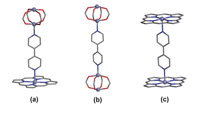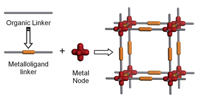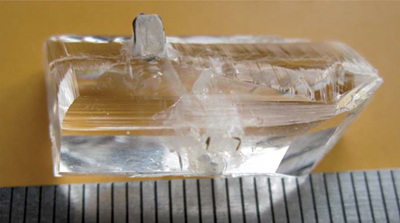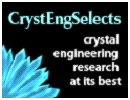Here is this week’s selection of advanced articles and accepted manuscripts of interest to crystal engineers from across the RSC journals
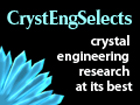 Articles are chosen from:
Articles are chosen from:
ChemComm,
Chemical Science,
CrystEngComm,
Dalton Transactions,
Journal of Materials Chemistry,
Nanoscale,
New Journal of Chemistry,
RSC Advances.
A triple helix of double helicates: three hierarchical levels of self-assembly in a single structure
Andrew Stephenson and Michael D. Ward
Chem. Commun., 2012, Advance Article
DOI: 10.1039/C2CC30197K, Communication
An asymmetric oligomer based on thienoacene for solution processed crystal organic thin-film transistors
Hongkun Tian, Yang Han, Cheng Bao, Donghang Yan, Yanhou Geng and Fosong Wang
Chem. Commun., 2012, Advance Article
DOI: 10.1039/C2CC30407D, Communication
Molecular chirality and chiral capsule-type dimer formation of cyclic triamides via hydrogen-bonding interactions
Noriko Fujimoto, Mio Matsumura, Isao Azumaya, Shizuka Nishiyama, Hyuma Masu, Hiroyuki Kagechika and Aya Tanatani
Chem. Commun., 2012, Advance Article
DOI: 10.1039/C2CC18177K, Communication
Highly Branched Pt-Ni Nanocrystals Enclosed by Stepped Surface
Zhiqiang Niu, Dingsheng Wang, Rong Yu, Qing Peng and Yadong Li
Chem. Sci., 2012, Accepted Manuscript
DOI: 10.1039/C2SC00004K, Edge Article
Kinetics and mechanism of metal–organic framework thin film growth: systematic investigation of HKUST-1 deposition on QCM electrodes
Vitalie Stavila, Joanne Volponi, Aaron M. Katzenmeyer, Matthew C. Dixon and Mark D. Allendorf
Chem. Sci., 2012, Advance Article
DOI: 10.1039/C2SC20065A, Edge Article
Morphology, wettability, and photomicropatterning of superhydrophobic surface with high adhesive force by crystal growth of a photochromic diarylethene
Daichi Kitagawa and Seiya Kobatake
Chem. Sci., 2012, Accepted Manuscript
DOI: 10.1039/C2SC20051A, Edge Article
Recent advances in porphyrinic metal–organic frameworks: materials design, synthetic strategies, and emerging applications
Brandon J. Burnett, Paul M. Barron and Wonyoung Choe
CrystEngComm, 2012, Advance Article
DOI: 10.1039/C2CE06692K
Facile solvothermal synthesis and growth mechanism of flower-like PbTe dendrites assisted by cyclodextrin
Rencheng Jin, Gang Chen, Jian Pei, Chunshuang Yan, Xian Zou, Mingda Deng and Shuai Sun
CrystEngComm, 2012, 14, 2327-2332
DOI: 10.1039/C2CE06417K
Coordination polymers, metal–organic frameworks and the need for terminology guidelines
Stuart R. Batten, Neil R. Champness, Xiao-Ming Chen, Javier Garcia-Martinez, Susumu Kitagawa, Lars Öhrström, Michael O’Keeffe, Myunghyun Paik Suh and Jan Reedijk
CrystEngComm, 2012, Advance Article
DOI: 10.1039/C2CE06488J
Progress in lead-based ferroelectric and antiferroelectric single crystals: composition modification, crystal growth and properties
Nengneng Luo, Yuanyuan Li, Zhiguo Xia and Qiang Li
CrystEngComm, 2012, Advance Article
DOI: 10.1039/C2CE06430H, Highlight
Lanthanide–tungstobismuthate clusters based on [BiW9O33]9− building units: synthesis, crystal structures, luminescent and magnetic properties
Keyu Cui, Fengyan Li, Lin Xu, Bingbing Xu, Ning Jiang, Yuchao Wang and Jianping Zhang
Dalton Trans., 2012, Advance Article
DOI: 10.1039/C2DT11478J, Paper
Chemo-switched chromatic, magnetic and structural changes with retention of molecular crystallinity, Ni(12aneS4)(BF4)2
Andrew J. Churchard, Mariana Derzsi, Zvonko Jagličić, Arndt Remhof and Wojciech Grochala
Dalton Trans., 2012, Advance Article
DOI: 10.1039/C2DT12468H, Paper
Highly crystalline strontium ferrites SrFeO3−δ: an easy and effective wet-chemistry synthesis
S. Diodati, L. Nodari, M. M. Natile, U. Russo, E. Tondello, L. Lutterotti and S. Gross
Dalton Trans., 2012, Advance Article
DOI: 10.1039/C2DT11916A, Paper
Growth of Zeolitic Imidazolate Framework-8 Crystals from the Solid-liquid Interface
Minqi Zhu, Jacek B Jasinski and MOISES A Carreon
J. Mater. Chem., 2012, Accepted Manuscript
DOI: 10.1039/C2JM30718A, Communication
Self-assembly of ZnO nanocrystals into nanoporous pyramids: high selective adsorption and photocatalytic activity Yunxin Liu, Jianxin Shi, Qing Peng and Yadong Li
J. Mater. Chem., 2012, Advance Article
DOI: 10.1039/C2JM16729H, Communication
Organotemplate-free and one-pot fabrication of nano-rod assembled plate-like micro-sized mordenite crystals
Limin Ren, Qiang Guo, Haiyan Zhang, Longfeng Zhu, Chengguang Yang, Liang Wang, Xiangju Meng, Zhaochi Feng, Can Li and Feng-Shou Xiao
J. Mater. Chem., 2012, Advance Article
DOI: 10.1039/C2JM30478C, Communication
Infrared colloidal lead chalcogenide nanocrystals: Synthesis, properties, and photovoltaic applications
Huiying Fu and Sai-Wing Tsang
Nanoscale, 2012, Advance Article
DOI: 10.1039/C2NR11836J, Review
Electrical and Thermal Properties of a Carbon Nanotube/Polycrystalline BiFeO3/Pt Photovoltaic Heterojunction with CdSe Quantum Dots Sensitization
Yongyuan Zang, Dan Xie, Yu Chen, Tian-Ling Ren, Hongwei Zhu and David Plant
Nanoscale, 2012, Accepted Manuscript
DOI: 10.1039/C2NR30084B, Paper
Photo-to-current response of Bi2Fe4O9 nanocrystals synthesized through a chemical co-precipitation process
Yongping Li, Yongcheng Zhang, Wanneng Ye, Jianqiang Yu, Chaojing Lu and Linhua Xia
New J. Chem., 2012, Advance Article
DOI: 10.1039/C2NJ40039A, Letter
Photonic crystal pH and metal cation sensors based on poly(vinyl alcohol) hydrogel
Hongliang Jiang, Yihua Zhu, Cheng Chen, Jianhua Shen, Hua Bao, Liming Peng, Xiaoling Yang and Chunzhong Li
New J. Chem., 2012, Advance Article
DOI: 10.1039/C2NJ20989F, Paper
Homochiral 1D-helical coordination polymers from achiral cucurbit[5]uril: hydroquinone-induced spontaneous resolution
Kai Chen, Ying-Feng Hu, Xin Xiao, Sai-Feng Xue, Zhu Tao, Yun-Qian Zhang, Qian-Jiang Zhu and Jing-Xin Liu
RSC Adv., 2012, Advance Article
DOI: 10.1039/C2RA01132H, Communication
H2Ti6O13, a new protonated titanate prepared by Li+/H+ ion exchange: synthesis, crystal structure and electrochemical Li insertion properties
J. C. Pérez-Flores, C. Baehtz, M. Hoelzel, A. Kuhn and F. García-Alvarado
RSC Adv., 2012, Advance Article
DOI: 10.1039/C2RA01134D, Paper
Synthesis of highly crystalline In2Ge2O7(En) hybrid sub-nanowires with ultraviolet photoluminescence emissions and their selective photocatalytic reduction of CO2 into renewable fuel
Qi Liu, Yong Zhou, Yue Ma and Zhigang Zou
RSC Adv., 2012, Advance Article
DOI: 10.1039/C2RA20186K, Communication
Remember you can keep up to date with all the latest news in crystal engineering by liking us on facebook, following us on twitter or signing up to our e-alert service.













